Charles E W Bean, Diaries, AWM38 3DRL 606/270 PART 3/1 - 1918 - 1939 - Part 4
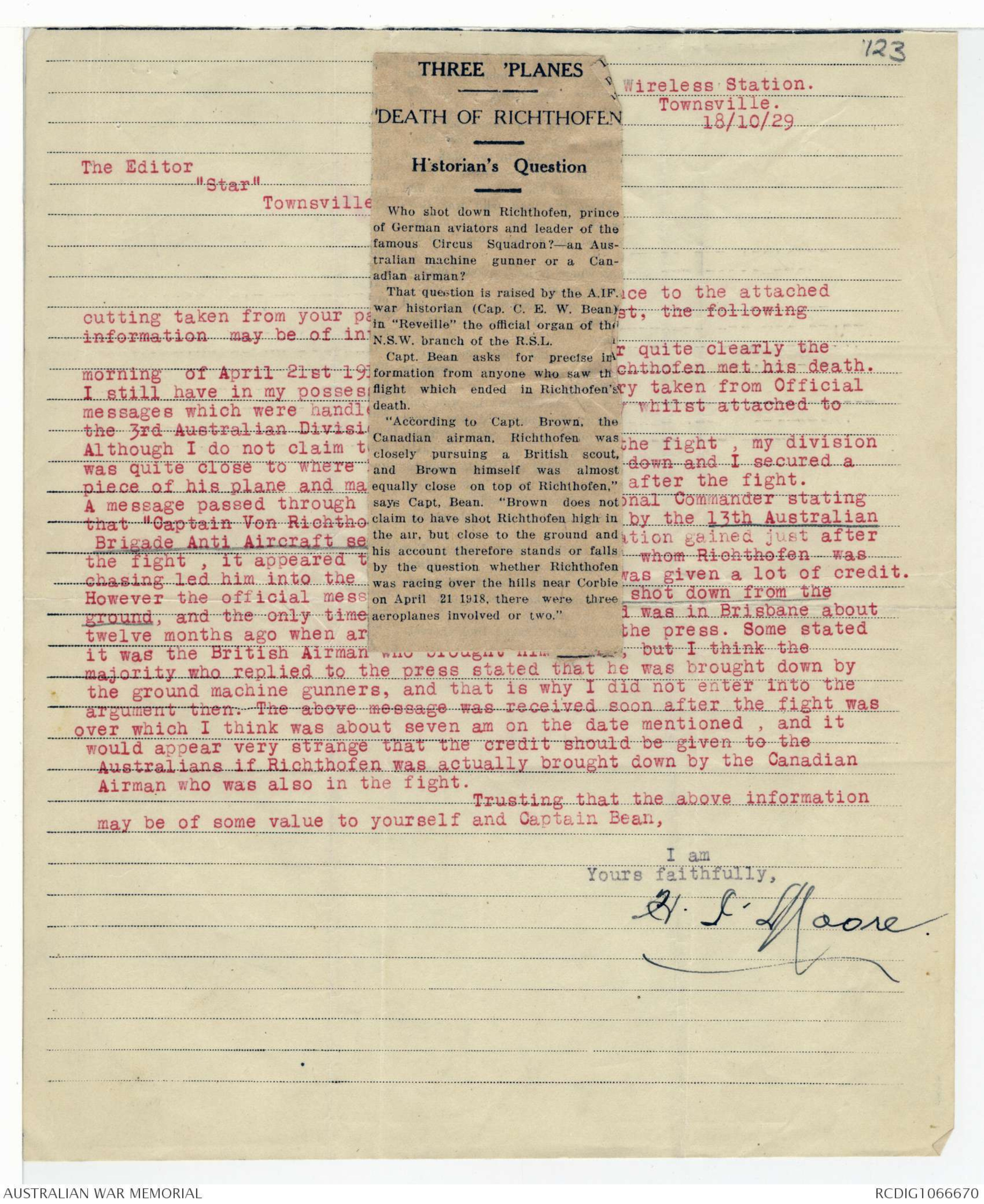
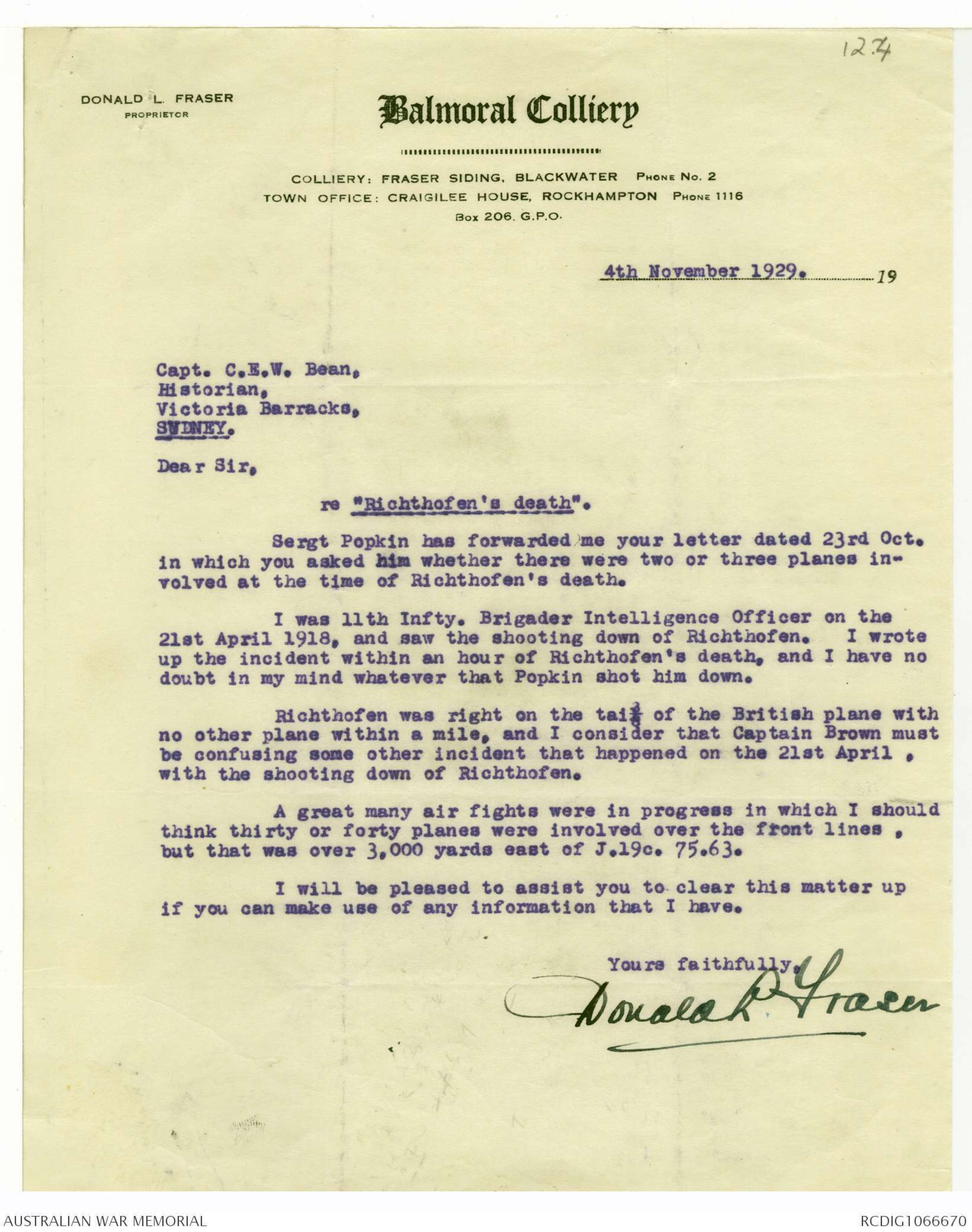
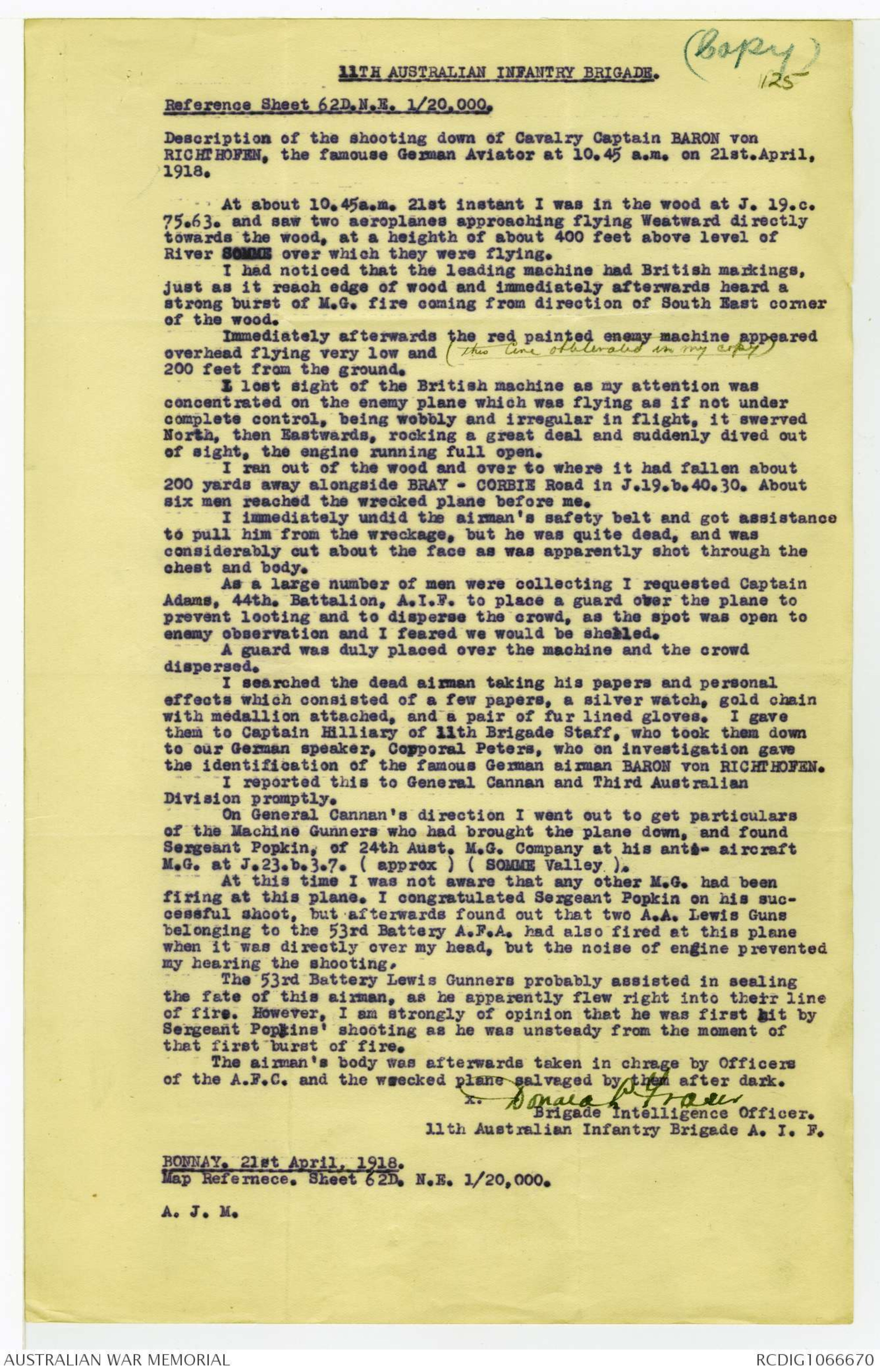
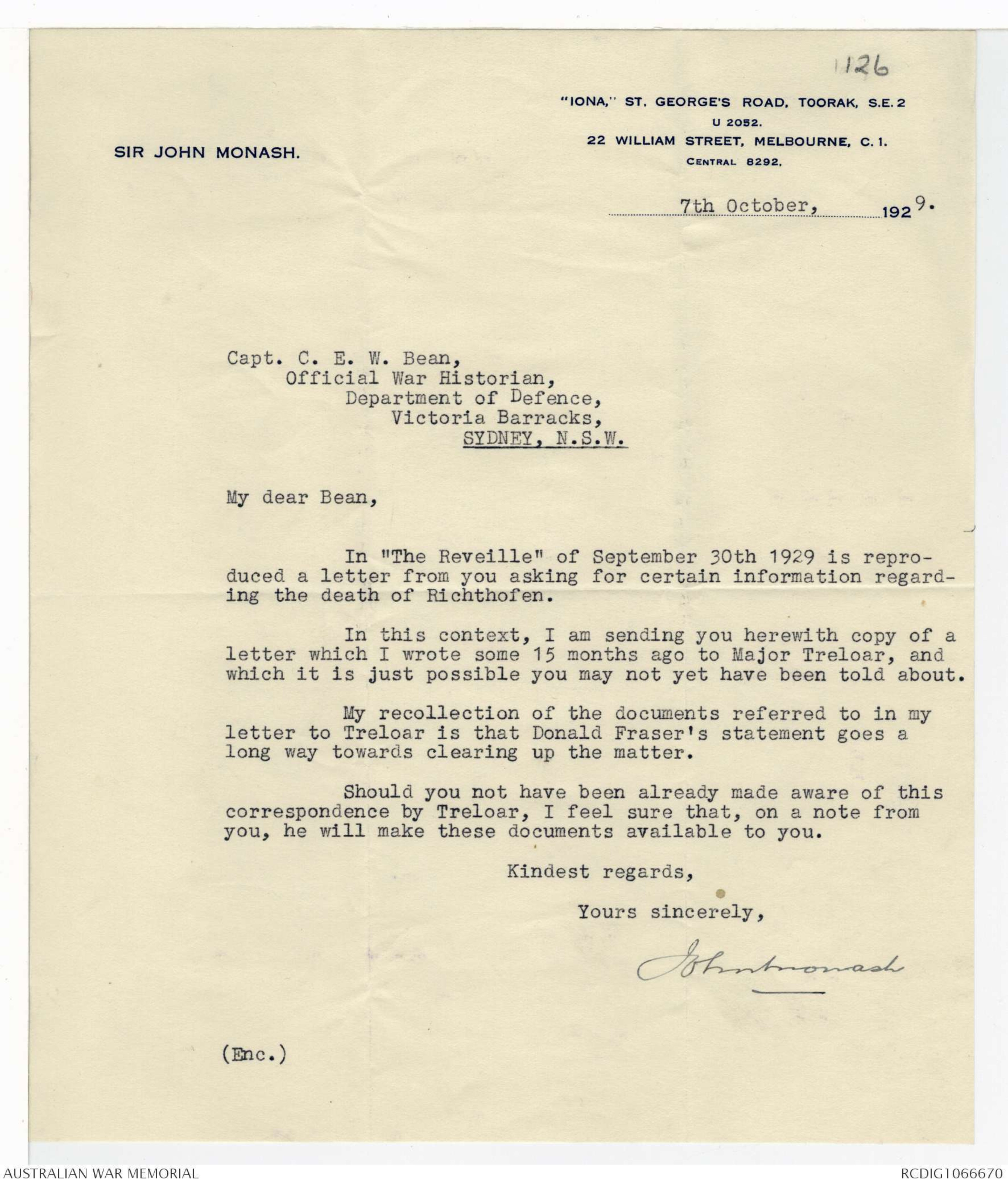
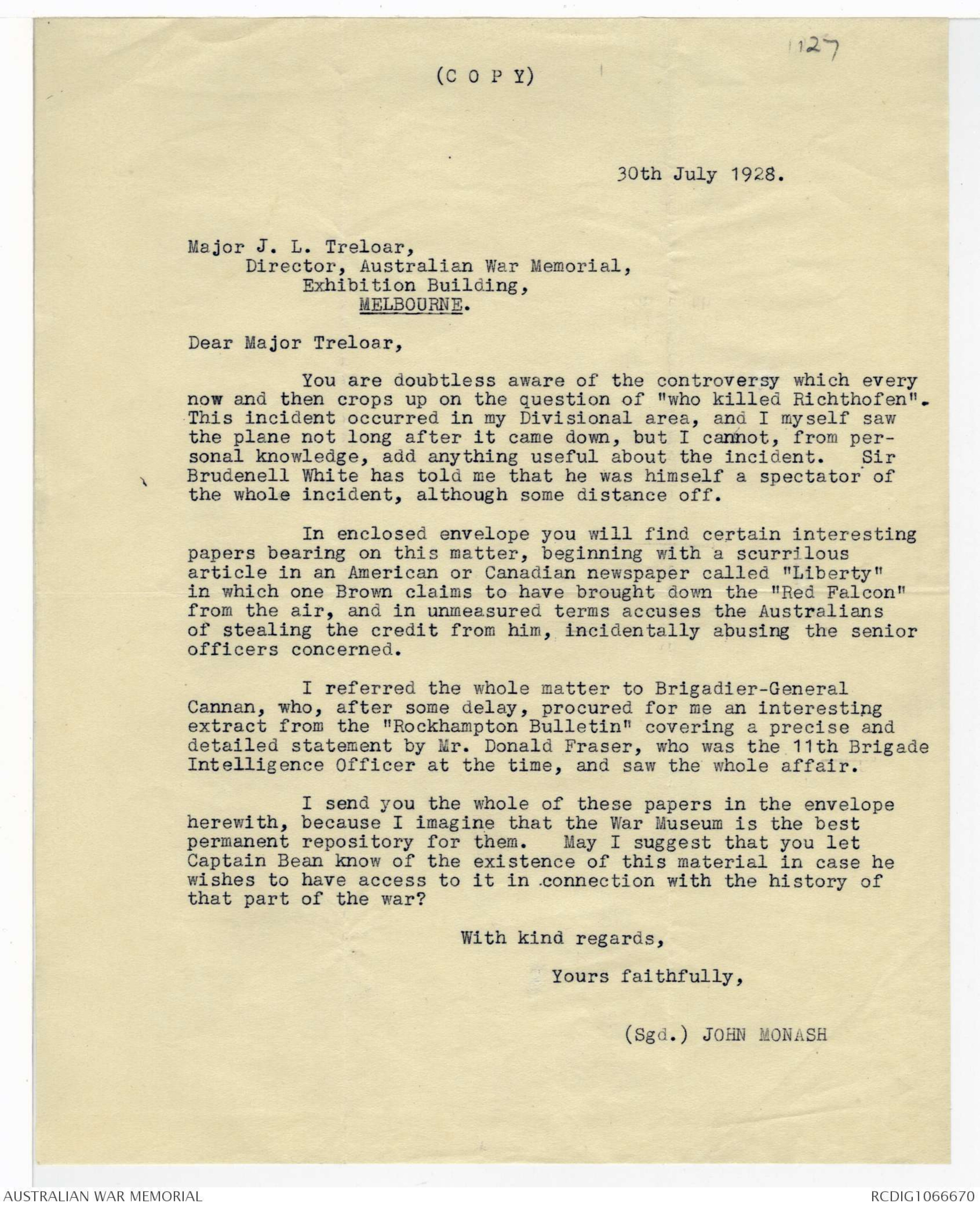

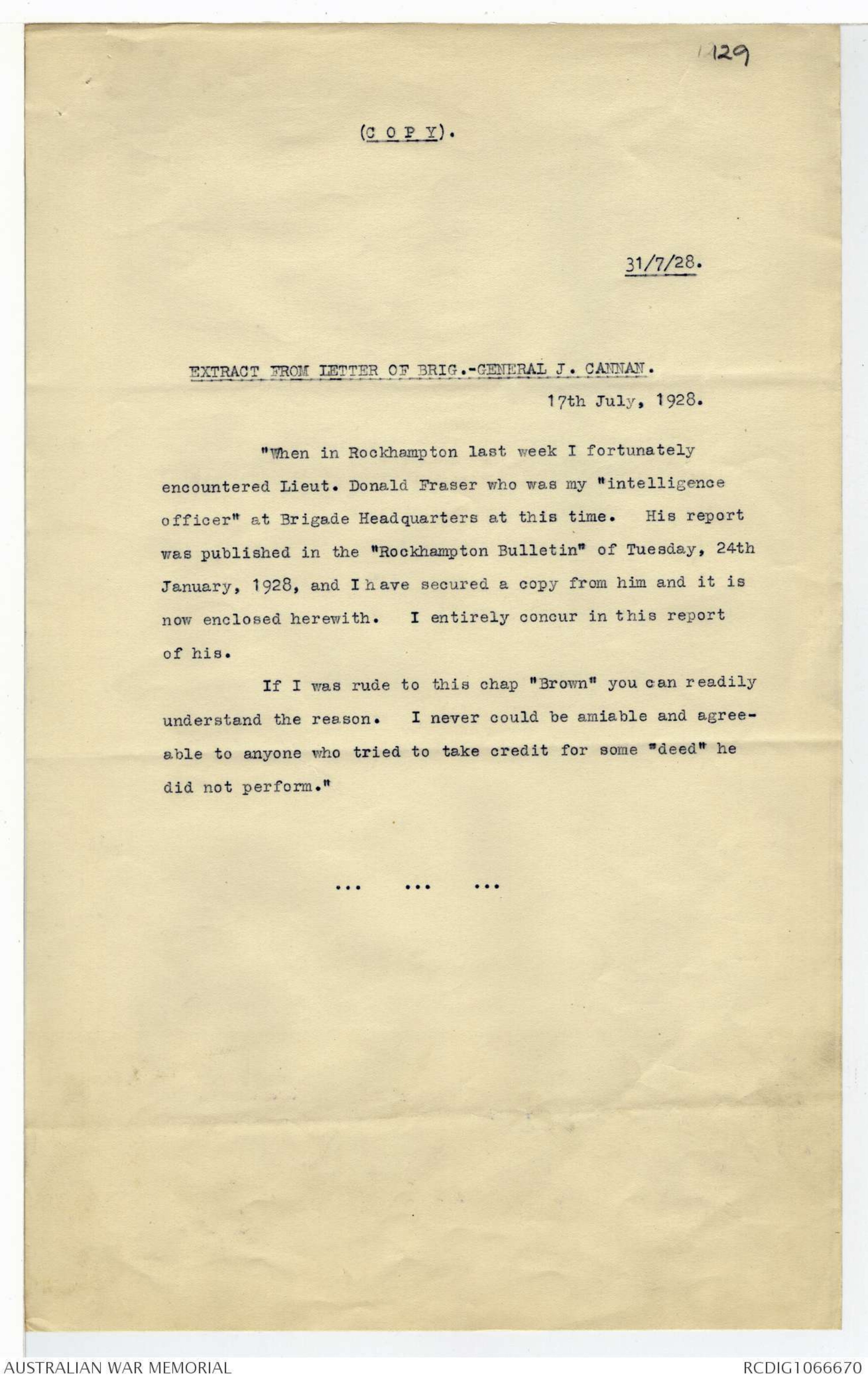
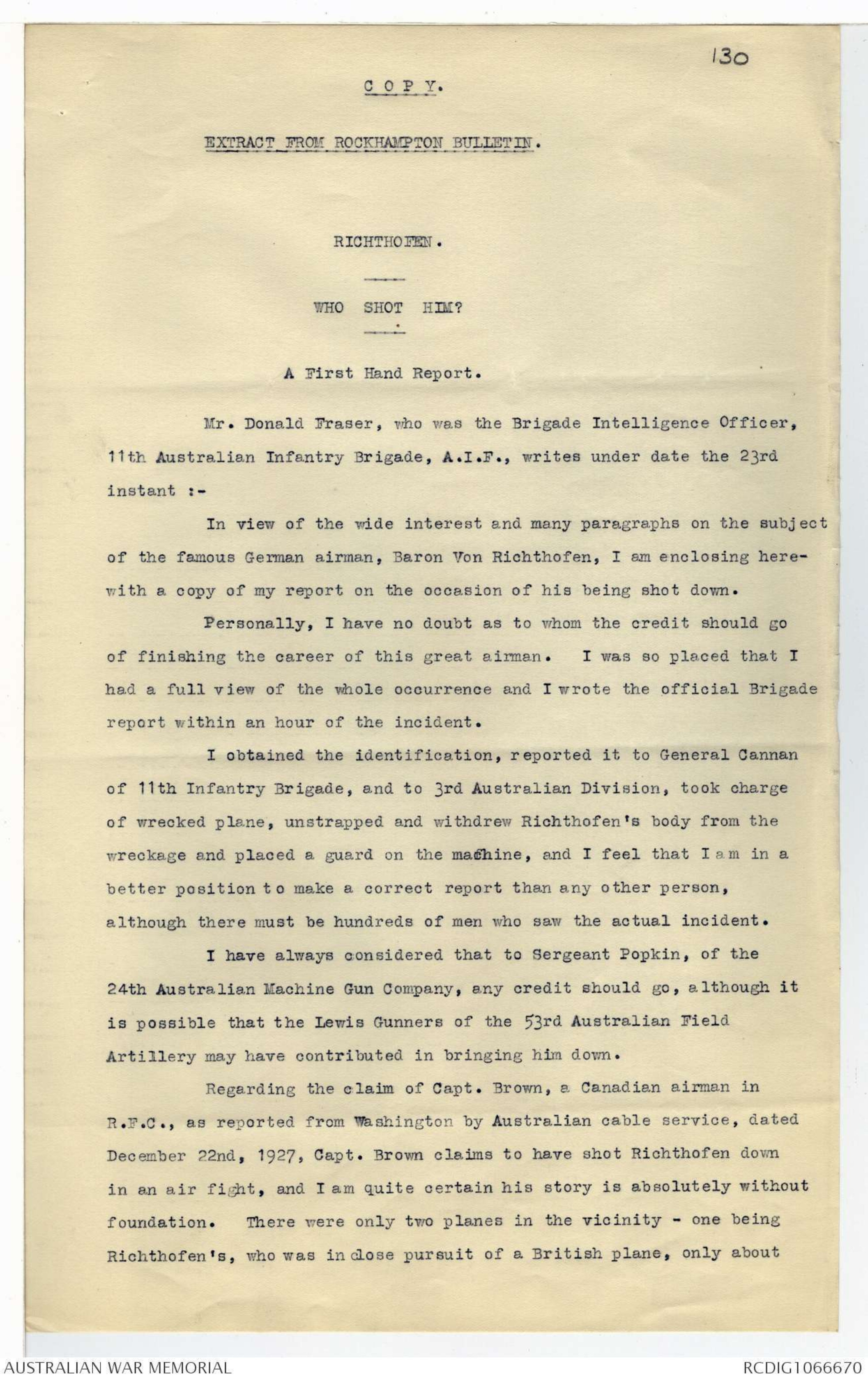


123
THREE 'PLANES
'DEATH OF RICHTHOFEN
Historian's Question
Who shot down Richthofen, prince
of German aviator's and leader of the
famous Circus Squadron? - an Australian/
machine gunner or a Canadian
airman?
That question is raised by the A.I.F.
war historian (Cap. C. E.W. Bean}
in "Reveille" the official organ of the
N.S.W. branch of the R.S.L.
Capt Bean asks for precise information
from anyone who saw the
flight which ended om Richthofen's
death.
"According to Capt. Brown, the
Canadian airman, Richthofen was
closely pursuing a British scout,
and Brown himself was almost
equally close on top of Richthofen."
says Capt, Bean. "Brown does not
claim to have shot Richthofen high in
the air, but close to the ground and
his account therefore stands or falls
by the question whether Richthofen
was racing over the hills of Corbie
on April 21 1918, there were three
aeroplanes involved or two"
Wireless Station.
Townsville. 18/10/29
The Editor
"Star"
Townsville
to the attached
cutting taken from your paper , the following
information may be of in
quite clearly the
morning of April 21st 19 chthoifen met his death.
I still have in my possession taken from Official
messages which were handled whilst attached to
the 3rd Australian Division
Although I do not claim to the fight, my division
was quite close to where down and I secured
a piece of his plane and ma after the fight.
A message passed through onal Commander stating
that "Captain Van Richtho by the 13th Australian
Brigade Anti Aircraft se ation gained just after
the fight, it appeared t whom Richthofen was
chasing led him into the was given a lot of credit.
However the official mess shot down from the
ground, and the only time d was in Brisbane about
twelve months ago when ar the press. Some stated
it was the British airman who bought him down, but I think the
majority who replied to the press stated that he was brought down by
the ground machine gunners, and that is why I did not enter into the
argument then. The above message was received soon after the fight was
over which I think was about 7 am on the date mentioned and it
would appear very strange that the credit should be given to the
Australians if Richthofen was actually brought down by the Canadian
Airman who was also in the fight.
Trusting that the above information
may be of value to yourself and Captain Bean,
I am
Yours faithfully,
H. J. Moore.
124
DONALD L FRASER
PROPRIETOR
Balmoral Colliery
COLLIERY: FRASER SIDING, BLACKWATER PHONE NO. 2
TOWN OFFICE: CRAIGILEE HOUSE, ROCKHAMPTON PHONE 1116
Box 206. G.P.O.
4th November 1929. 19
Capt. C.E.W. Bean,
Historian,
Victoria Barracks,
SYDNEY.
Dear Sir,
re "Richthofen's death".
Sergt Popkin has forwarded me your letter dated 23rd Oct.
in which you asked him whether there were two or three planes involved
at the time of Richthofen's death.
I was 11th Infty. Brigader Intelligence Officer on the
21st April 1918, and saw the shooting down of Richthofen. I wrote
up the incident within an hour of Richthofen's death, and I have no
doubt in my mind whatever that Popkin shot him down.
Richthofen was right on the tail of the British plane with
no other plane within a mile, and I consider that Captain Brown must
be confusing some other incident that happened on the 21st April,
with the shooting down of Richthofen.
A great many air fights were in progress in which I shoüld
think thirty or forty planes were involved over the front lines,
but that was over 3,000 yards east of J.19c. 75.63.
I will be pleased to assist you to clear this matter up
if you can make use of any information that I have.
Yours faithfully,
Donald L Fraser
Brigade Intelligence Officer.
11 Australian Infantry Brigade A.I.F.
BONNAY. 21st April, 1918.
Map Reference. Sheet 621D. N.E. 1/20,0000.
A. J. M.
(Copy)
125
11TH AUSTRALIAN INFANTRY BRIGADE.
Reference Sheet 62D.N.E. 1/20,000.
Description of the shooting down of Cavalry Captain BARON von
RICHTHOYEN, the famouse German Aviator at 10.45 a.m. on 21st. April,
1918.
At about 10.45a.m. 21st instant I was in the wood at J. 19.c.
75.63. and saw two aeroplanes approaching flying Westward directly
towards the wood, at a heighth of about 400 feet above level of
River SOMME over which they were flying.
I had noticed that the leading machine had British markings,
just as it reach edge of wood and immediately afterwards heard a
strong burst of M.G. fire coming from direction of South East corner
of the wood.
Immediately afterwards the red painted enemy machine appeared
overhead flying very low and (This line obliterated in my copy)
200 feet from the ground.
I lost sight of the British machine as my attention was
concentrated on the enemy plane which was flying as if not under
complete control, being wobbly and irregular in flight, it swerved
North, then Eastwards, rocking a great deal and suddenly dived out
of sight, the engine running full open.
I ran out of the wood and over to where it had fallen about
200 yards away alongside BRAY - CORBIE Road in J.19.b.40.30. About
six men reached the wrecked plane before me.
I immediately undid the airman's safety belt and got assistance
to pull him from the wreckage, but he was quite dead, and was
considerably cut about the face as was apparently shot through the
chest and body.
As a large number of men were collecting I requested Captain
Adams, 44th. Battalion, A.I.F. to place a guard over the plane to
prevent looting and to disperse the crowd, as the spot was open to
enemy observation and I feared we would be shelled.
A guard was duly placed over the machine and the crowd
dispersed.
I searched the dead airman taking his papers and personal
effects which consisted of a few papers, a silver watch, gold chain
with medallion attached, and a pair of fur lined gloves. I gave
them to Captain Hilliary of 11th Brigade Staff, who took them down
to our German speaker, Corporal Peters, who on investigation gave
the identification of the famous German airman BARON von RICHTHOFEN.
I reported this to General Cannan and Third Australian
Division promptly.
On General Cannan's direction I went out to get particulars
of the Machine Gunners who had brought the plane down, and found
Sergeant Popkin, of 24th Aust. M.G. Company at his anti- aircraft
M.G. at J.23.b.3.7. (approx) (SOMME Valley).
At this time I was not aware that any other M.G. had been
firing at this plane. I congratulated Sergeant Popkin on his successful
shoot, but afterwards found out that two A.A. Lewis Guns
belonging to the 53rd Battery A.F.A. had also fired at this plane
when it was directly over my head, but the noise of engine prevented
my hearing the shooting.
The 53rd Battery Lewis Gunners probably assisted in sealing
the fate of this airman, as he apparently flew right into their line
of fire. However, I am strongly of opinion that he was first hit by
Sergeant Popkins' shooting as he was unsteady from the moment of
that first burst of fire.
The airman's body was afterwards taken in chrage by Officers
of the A.F.C. and the weecked plane salvaged by them after dark.
x. Donald L Fraser
rigade intelligence Officer.
1lth Australian Infantry Brigade A. I. F.
RupmaY. alsi
Map Reiernece. Steet N.E. 1/20,000.
A. J. M.
126
"IONA" ST. GEORGES ROAD, TOORAK SE.2
U 2032.
22 WILLIAM STREET, MELBOURNE, C.I.
SIR JOHN MONASH.
CENTRAL 8292.
7th October. 1929.
Capt. C. E. W. Bean,
Official War Historian,
Department of Defence,
Victoria Barracks,
SYDNEY, N.S.W
My dear Bean,
In "The Reveille" of September 30th 1929 is reproduced
a letter from you asking for certain information regarding
the death of Richthofen.
In this context, I am sending you herewith copy of a
letter which I wrote some 15 months ago to Major Treloar, and
which it is just possible you may not yet have been told about.
My recollection of the documents referred to in my
letter to Treloar is that Donald Fraser's statement goes a
long way towards clearing up the matter.
Should you not have been already made aware of this
correspondence by Treloar, I feel sure that, on a note from
you, he will make these documents available to you.
Kindest regards,
Yours sincerely,
John Monash
(Enc.)
127
(COPY)
30th July 1928.
Major J. L. Treloar,
Director, Australian War Memorial,
Exhibition Building,
MELBOURNE.
Dear Major Treloar,
You are doubtless aware of the controversy which every
now and then crops up on the question of "who killed Richthofen"-
This incident occurred in my Divisional area, and I myself saw
the plane not long after it came down, but I cannot, from personal
knowledge, add anything useful about the incident. Sir
Brudenell White has told me that he was himself a spectator of
the whole incident, although some distance off.
In enclosed envelope you will find certain interesting
papers bearing on this matter, beginning with a scurrilous
article in an American or Canadian newspaper called "Liberty"
in which one Brown claims to have brought down the "Red Falcon"
from the air, and in unmeasured terms accuses the Australians
of stealing the credit from him, incidentally abusing the senior
officers concerned.
I referred the whole matter to Brigadier-General
Cannan, who, after some delay, procured for me an interesting
extract from the "Rockhampton Bulletin" covering a precise and
detailed statement by Mr. Donald Fraser, who was the 11th Brigade
Intelligence Officer at the time, and saw the whole affair.
I send you the whole of these papers in the envelope
herewith, because I imagine that the War Museum is the best
permanent repository for them.
May I suggest that you let
Captain Bean know of the existence of this material in case he
wishes to have access to it in connection with the history of
that part of the war?
With kind regards,
Yours faithfully,
(Sgd.) JOHN MONASH
128
T/FMG.
TELEPHONE Nos.
F 2597
F 2598
TELEGRAPHIC ADDRESS
COMMONWEALTH OF AUSTRALIA.
"AUSWARMUSE.
COMMUNICATIONS TO BR ADDRESSED TO
"THE DIRECTOR"
IN REPLY PLEASE QUOTE
NO 7/1/40.
AUSTRALIAN WAR MEMORIAL,
POST OFFICE BOX 214D.
EXHIBITION BUILDINGS, MELBOURNE.
"They gave their LIves. For that public gift they
received a praise which never ages and
tomb most glorious —not so much the tomb in
which they liee, but that in which their fame
survives, to be remembered for ever when occasion
comes for word or deed .. . . ."
15th October, 1929.
Dear Mr. Bazley,
With reference to your letter No.4974 of the
11th October relative to certain Richthofen papers received by
the War Memorial from General Monash, under cover of a letter
dated 30th July Sir John forwarded to the Memorial a copy of
an article by A. R. Brown which appeared in "Liberty" 17th
December, 1927, a typed extract from a letter dated 17th July,
1928, from Brigadier-General J. H. Cannan, and the cutting from
the Rockhampton Bulletin referred to in your letter.
With a letter dated 1st August, 1928, I forwarded
to Mr. Bean a copy of the acknowledgment which I sent to Sir
John and also described the papers which we had received from
him. In that letter I stated that I understood Mr. Heyes
had forwarded to Mr. Bean the article from "Liberty". I am
now sending herewith a copy of the extract from Brig.-General
Cannan's letter and of the cutting from the Rockhampton Bulletin.
Is the controversy regarding the death of
Richthofen springing to life again?
Yours sincerely,
JP Treloar
Mr. A. W. Bazley,
C/o Official Historian
Victoria Barracks,
PADDINGTON, N.S.W.
129
(COPY).
31/7/28.
EXTRACT FROM LETTER OF BRIG.-GENERAL J. CANNAN.
17th July, 1928.
"When in Rockhampton last week I fortunately
encountered Lieut. Donald Fraser who was my "intelligence
officer" at Brigade Headquarters at this time. His report
was published in the "Rockhampton Bulletin" of Tuesday, 24th
January, 1928, and I have secured a copy from him and it is
now enclosed herewith. I entirely concur in this report
of his.
If I was rude to this chap "Brown" you can readily
understand the reason. I never could be amiable and agreeable
to anyone who tried to take credit for some "deed" he
did not perform."
130
COPY.
EXTRACT FROM ROCKHAMPTON BULLETIN.
RICHTHOFEN.
WHO SHOT HIM?
A First Hand Report.
Mr. Donald Fraser, who was the Brigade Intelligence Officer,
11th Australian Infantry Brigade, A.I.F., writes under date the 23rd
instant:-
In view of the wide interest and many paragraphs on the subject
of the famous German airman, Baron Von Richthofen, I am enclosing herewith
a copy of my report on the occasion of his being shot down.
Personally, I have no doubt as to whom the credit should go
of finishing the career of this great airman. I was so placed that I
had a full view of the whole occurrence and I wrote the official Brigade
report within an hour of the incident.
I obtained the identification, reported it to General Cannan
of 11th Infantry Brigade, and to 3rd Australian Division, took charge
of wrecked plane, unstrapped and withdrew Richthofen's body from the
wreckage and placed a guard on the machine, and I feel that I am in a
better position to make a correct report than any other person,
although there must be hundreds of men who saw the actual incident.
I have always considered that to Sergeant Popkin, of the
24th Australian Machine Gun Company, any credit should go, although it
is possible that the Lewis Gunners of the 53rd Australian Field
Artillery may have contributed in bringing him down.
Regarding the claim of Capt. Brown, a Canadian airman in
R.F.C., as reported from Washington by Australian cable service, dated
December 22nd, 1927, Capt. Brown claims to have shot Richthofen down
in an air fight, and I am quite certain his story is absolutely without
foundation. There were only two planes in the vicinity - one being
Richthofen's, who was in close pursuit of a British plane, only about
130a
- 2 -
50 yards separating them, and this British plane was absolutely at
Richthofen's mercy and would have been shot down within a few
seconds had the German airman not been killed. It was quite
impossible for the pilot in the pursued plane to have shot at his
pursuer, in the position as I saw them.
Captain Brown's plane was not even sighted by any of those
who saw Richthofen's death, and it has been conclusively proved that
Richthofen died instantly as the result of a bullet through the
heart, so that it is apparent that Brown has drawn wholly on his
imagination in his desire for notoriety.
The report sent in by Lieut. Fraser is dated Bonnay,
April 21st, 1918, and is as follows :-
Australian Infantry Brigade.
Reference Sheet, Corbie, 1/20,000.
Description of the shooting down of Cavalry Captain Baron
von Richthofen, the famous German aviator, at 10.45 on 21st April,
1918:-
At about 10.45 a.m., 21st instant, I was in the wood at
J.19 75,63 and saw two aeroplanes approaching, flying westward,
directly towards the wood, at a height of about 400 feet above
level of River Somme over which they were flying.
I had noted that the leading machine had British markings,
just as it reached edge of wood and immediately afterwards heard a
strong burst of M.G. fire coming from direction of south-east corner
of the wood.
Immediately afterwards the red painted enemy machine appeared
overhead, flying very low and unsteadily, and probably not more than
200 ft. from the ground.
I lost sight of the British machine, as my attention was
concentrated on the enemy plane, which was flying as if not under
complete control, being wobbly and irregular in flight. It
swerved north, then eastwards, rocking a great deal and suddenly
dived out of my sight, the engine still running full open.
I ran out of the wood and over to where it had fallen, about
130b
-3-
200 yards away alongside Bray-Corbie-road. About six men reached
the wrecked plane before me.
I immediately undid the airman's safety belt and got
assistance to pull him from the wreckage, but he was quite dead,
and was considerably cut about the face, and was apparently shot
through the chest and body.
As a large number of men were collecting, I requested
Captain Adams, 4th Battalion, A.I.F., to place a guard over the
plane to prevent looting, and to disperse the crowd, as the spot
was open to enemy observation and I feared we would be shelled.
A guard was duly placed over the machine and the crowd
dispersed.
I searched the dead airman, taking his papers and personal
effects, which consisted of a few papers, a silver watch, gold
chain with medallion attached, and a pair of fur-lined gloves.
I gave them to Captain Hilliary, of 11th Brigade Staff, who took
them down to our German speaker. Corporal Peters, who, on
investigation, gave the identification of the famous German airman,
Baron von Richthofen.
I reported this to General Cannan and Third Australian
Division promptly.
On General Cannan's direction I went out to get particulars
of the machine gunners, who had brought the plane down, and found
Sergeant Popkin, of 24th Australian M.G. Company, at his anti-aircraft
M.G. location.
At this time I was not aware that any other M.G. had been
firing at this plane. I congratulated Sergeant Popkin on his
successful shoot, but afterwards found out that two A.A. Lewis
gunners belonging to the 53rd Battery A.F.A. had also fired at this
plane when it was directly over my head, but the noise of engine
prevented my hearing the shooting.
The 53rd Battery Lewis gunners probably assisted in sealing
the fate of this airman, as he apparently flew right into their
line of fire. However, I am strongly of opinion that he was first
 Sandy Mudie
Sandy MudieThis transcription item is now locked to you for editing. To release the lock either Save your changes or Cancel.
This lock will be automatically released after 60 minutes of inactivity.